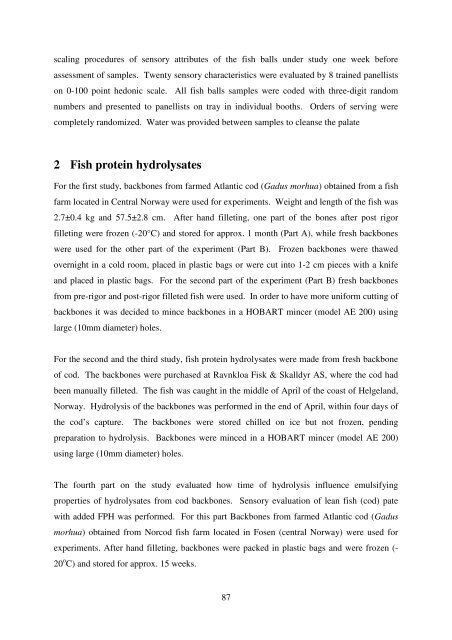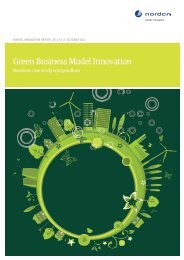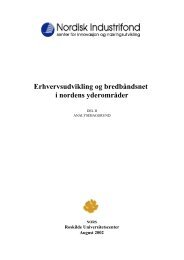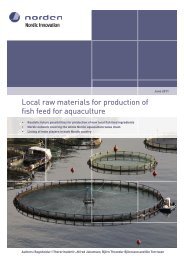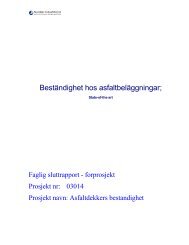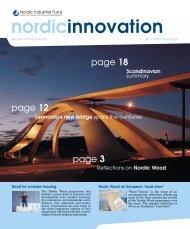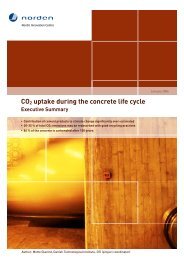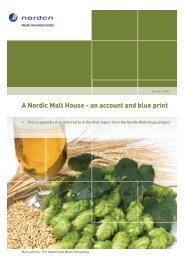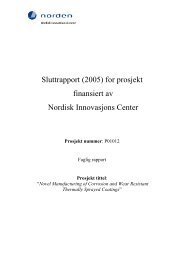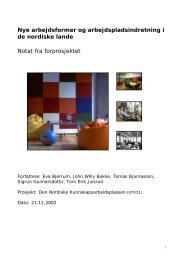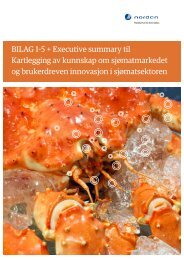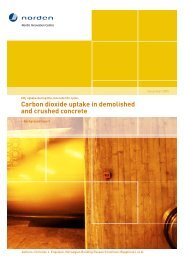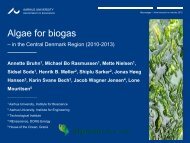Value added fish by-products - Nordic Innovation
Value added fish by-products - Nordic Innovation
Value added fish by-products - Nordic Innovation
You also want an ePaper? Increase the reach of your titles
YUMPU automatically turns print PDFs into web optimized ePapers that Google loves.
scaling procedures of sensory attributes of the <strong>fish</strong> balls under study one week before<br />
assessment of samples. Twenty sensory characteristics were evaluated <strong>by</strong> 8 trained panellists<br />
on 0-100 point hedonic scale. All <strong>fish</strong> balls samples were coded with three-digit random<br />
numbers and presented to panellists on tray in individual booths. Orders of serving were<br />
completely randomized. Water was provided between samples to cleanse the palate<br />
2 Fish protein hydrolysates<br />
For the first study, backbones from farmed Atlantic cod (Gadus morhua) obtained from a <strong>fish</strong><br />
farm located in Central Norway were used for experiments. Weight and length of the <strong>fish</strong> was<br />
2.7±0.4 kg and 57.5±2.8 cm. After hand filleting, one part of the bones after post rigor<br />
filleting were frozen (-20°C) and stored for approx. 1 month (Part A), while fresh backbones<br />
were used for the other part of the experiment (Part B). Frozen backbones were thawed<br />
overnight in a cold room, placed in plastic bags or were cut into 1-2 cm pieces with a knife<br />
and placed in plastic bags. For the second part of the experiment (Part B) fresh backbones<br />
from pre-rigor and post-rigor filleted <strong>fish</strong> were used. In order to have more uniform cutting of<br />
backbones it was decided to mince backbones in a HOBART mincer (model AE 200) using<br />
large (10mm diameter) holes.<br />
For the second and the third study, <strong>fish</strong> protein hydrolysates were made from fresh backbone<br />
of cod. The backbones were purchased at Ravnkloa Fisk & Skalldyr AS, where the cod had<br />
been manually filleted. The <strong>fish</strong> was caught in the middle of April of the coast of Helgeland,<br />
Norway. Hydrolysis of the backbones was performed in the end of April, within four days of<br />
the cod’s capture. The backbones were stored chilled on ice but not frozen, pending<br />
preparation to hydrolysis. Backbones were minced in a HOBART mincer (model AE 200)<br />
using large (10mm diameter) holes.<br />
The fourth part on the study evaluated how time of hydrolysis influence emulsifying<br />
properties of hydrolysates from cod backbones. Sensory evaluation of lean <strong>fish</strong> (cod) pate<br />
with <strong>added</strong> FPH was performed. For this part Backbones from farmed Atlantic cod (Gadus<br />
morhua) obtained from Norcod <strong>fish</strong> farm located in Fosen (central Norway) were used for<br />
experiments. After hand filleting, backbones were packed in plastic bags and were frozen (-<br />
20 o C) and stored for approx. 15 weeks.<br />
87


